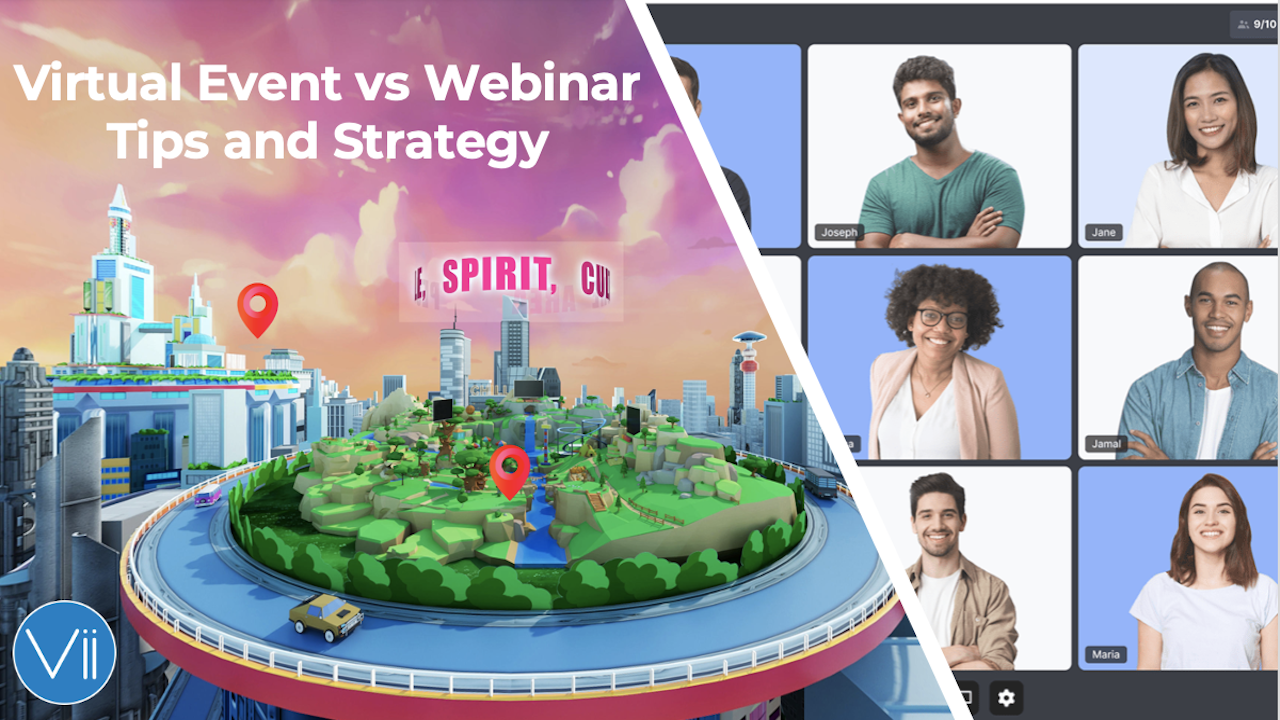These days, with total digitalization, we constantly encounter ads, companies, or even our friends who share that they have visited a webinar or a virtual event. These modern means of social interactions are becoming widely popular and can be used with obvious benefits for one’s business or company. But before going to useful tips and strategies, it is important to establish is a webinar a virtual event? Or maybe they have some crucial differences?
A webinar is a relatively short online event. Most frequently, webinars are used as interactive ways of connecting with one’s guests in a private atmosphere. During webinars, hosts and their guests discuss a single topic for a specified period of time. Most frequently, a webinar takes about an hour.
During webinars, one may encounter a number of visual and interactive elements, including streaming, whiteboards, chats, slide sharing, and other elements. Typically, webinars have a set structure, and guests are allowed to ask questions. Finally, the host draws conclusions about the discussed topic and closes the webinar.
In turn, virtual events are much broader than webinars and include many more features and elements. A virtual event is a multiply component, multi-session event that takes way more time than a webinar. It can be anything, from gatherings and discussions to team buildings and announcements. Each virtual event is unique and has its own spirit and identity designed for each occasion separately. The main goal of such an approach is to make it unique and interesting for the audience. Therefore, it is possible to ensure a guest’s engagement via interactive elements of different kinds.
Webinars and Virtual Events: What Differentiates Them?
It may get a bit confusing since a webinar is, in fact, a virtual event. The reason is that during a webinar, people interact online in a specially designed virtual environment. However, webinars can’t cover all the possible events one may need to conduct. For example, it takes way more than a webinar to launch a product, present new ideas, arrange networking sessions, shows, etc.
Such events are much more complex, and while they can’t be arranged without webinars, solely webinars are not enough to completely suit the need. Therefore, virtual events go way beyond webinars in terms of arranging online interactive activities. A webinar is a narrow tool that can be utilized for achieving specific goals and purposes.
Difference in Scope
While webinars can be pretty massive, they are not at all comparable to virtual events. The latter ones are much larger and have a significantly bigger audience and greater bandwidth. The reason behind this is that while attendees of a webinar are united by a single goal, those of a virtual event usually have vastly diversified reasons to attend an event. Such diversity of purposes brings a lot more people to a virtual event than to a webinar.
Flexibility
Virtual events, with all their elements and tools, offer a much easier way to express one’s narrative of their brand or the event. For comparison, a webinar allows for only a tiny bit of possible interactions, while virtual events allow going much further in terms of providing your guests with an immersive brand experience and creating emotional responses and connections to one’s product or offer.
Freedom
Virtual events offer a wide range of possible content, allowing one to adapt it to whatever the needs one may have. In a virtual event, attendees are not limited to a single topic. It is a free world with multiple engagements and activities that every participant can choose from at any given time. Thus, participants can visit only those events that suit their interests and check out everything else in the recording. In turn, during a webinar, one is a part of a single pre-defined linear experience.
Networking & Communication
Virtual Events are also about communication allowing the creation and building of lasting relationships that later may result in new business opportunities. While the webinar focuses on providing content and information, virtual events facilitate interaction between the attendees.
Virtual events length
Virtual events can go on for several days, and usually, after the end, it turns into a community mode(also known as Video on demand (VOD) mode). Where people still can go and revisit the content and network with the people who attended the event, while the webinar is more a singular activity-oriented. Furthermore, Virtual Events Can host multiple webinars during them or have them on an ongoing basis in the community 365 models.
Engagement levels
Considering what we have already discussed, webinars offer a way lower engagement level than virtual events. The reason behind it is that the latter offers a diverse number of possible options to the attendees. In turn, webinars have a strict and rigid structure which often becomes a constraining factor for their engagement. Due to limited options, attendees can interact and communicate only in a limited frame. When comparing a rigid and imitated webinar with a virtual event it is clear that the latter has a full range of various activities and fun interactions to offer. Thus, it becomes clear why virtual events are so much easier for attendees to immerse in.
Days of mass marketing are numbered, which puts a special value on webinars and online events, as they allow one to create personal ties between the business and its customers. Check Catherine King’s Video from our A2Z Hybrid London 2022 Event to learn more about the role of Big Data and all the possibilities virtual events provide you.
Role of Big Data in Virtual Events

Tips and Strategy for Your Virtual Events
Bearing in mind the importance of a personal approach, webinars are the best when one needs to deliver some marketing information, but only if they clearly understand the limitations. At the same time, virtual events are way more flexible and offer a wider range of tools and opportunities to engage with one’s guests and offer them a quality virtual experience. When we draw a clear line between webinars and virtual events, the time has come to share several tips on how to increase attendance at virtual events and ensure the success of a virtual event.
- Ease the Registration procedure
One of the most effective ways to increase attendance at virtual events is to ease registration as much as possible. The online environment is full of distractions, and your attendees may have flooded inboxes, have daily virtual meetings, and constantly get notifications from messengers and social media. It makes no sense to compete for a person’s attention with all those elements. For this very reason, it is crucial to provide your core audience with easy access to your event. Once you have caught their interest on social media or any other source, ensure that when the time of the event comes, they won’t need to perform a tremendous number of actions to access it.
- Add Interactive elements
To help your attendees adapt and get access to information about the topics, it is important to add interactive elements and ensure the event has a friendly atmosphere where people can freely ask questions and share thoughts and ideas. By encouraging your audience to take action, you will be able to help people turn from bystanders into active attendees. Gamification is a powerful example of such interactive elements that help with networking, tune guests to a positive and working mood and help to set the desired atmosphere for the event. If you are looking for ideas on how to increase attendance at virtual events and strengthen involvement, consider referring to our virtual event kit – a complete turnkey solution for your business or company.
- Showcase the event
These days everyone loves to watch original content, especially the one in the form of video. By creating a short vid for several social media and uploading it to video platforms, it will be possible to draw more attention to the event. Add a dedicated discount code to the video to increase the sign-up rate.
- Communication and Networking
Communication is the key to the success of any virtual event. Through fruitful communication and networking, attendees obtain valuable information, generate ideas, find new ways of cooperation, and grow their businesses together by encouraging your audience to organize virtual meet-ups and share their interests in the search for like-minded people. It is worth allowing the guest to chat directly with the organizers. Thus, guests will be able to share their ideas, and it will be easier to estimate virtual event success metrics to measure the event success.
- Consistent Promotion Campaign
It is crucial to continue pushing your promotion campaign till the very start of your event. Warm-up your audience before the event and continue growing their interest till the very beginning of the event. Otherwise, they may not show up due to already mentioned online distractions. The number of registrations is one of the most misleading virtual event success metrics because not all of them will convert into attendees. A consistent promotion campaign is a helpful tool to raise the conversion.
Conducting virtual events and webinars can be tricky, but it always pays off when done right. We encourage you to work only with real professionals in the field of virtual events and metaverse. Thus, you will achieve the greatest results and get all the necessary virtual event success metrics in an easy-to-read form. Open a new window of opportunity for your business with Vii.
If you have any questions, please feel free to contact us at any time.

